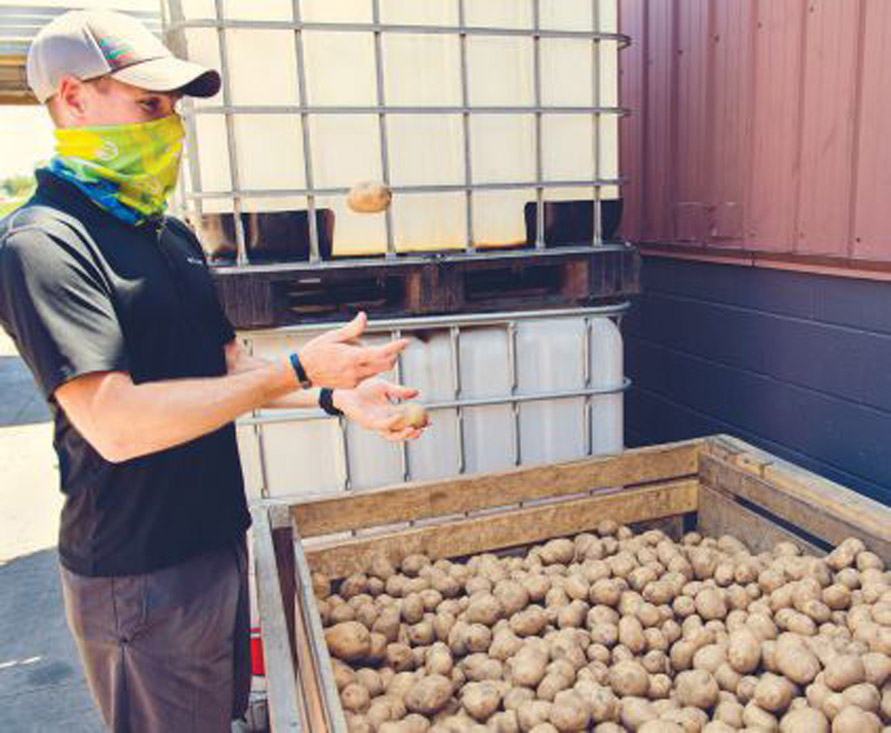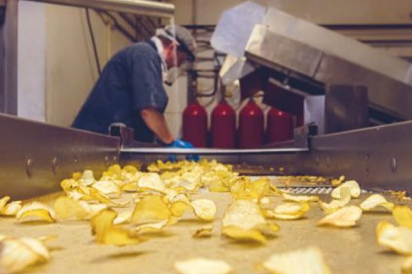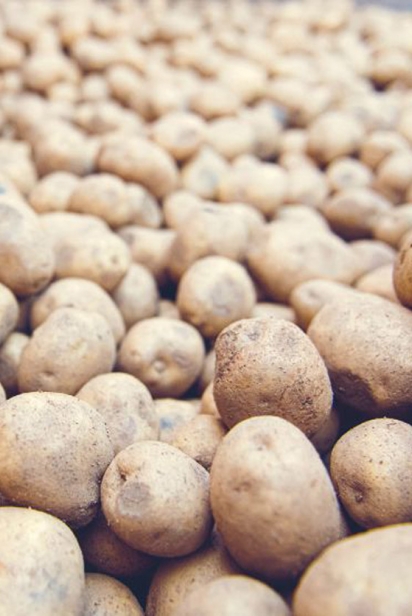This Spud’s for you, Great Lakes Potato Chips Cranks out Comfort Food for Uncomfortable Times
Since my Grandma Zielinski first poured Better Made potato chips into a green glass bowl and set it on her Detroit coffee table for us kids, I have associated potato chips with love. And fun. And family.
My brothers and I even fantasized about starting a potato chip company together. But I guess you don’t need a childhood passion for chips to know how to make and sell them. At least Chris Girrbach, a pretzel person as a kid in downriver Detroit, hasn’t done too badly. As president of Great Lakes Potato Chips in Traverse City, MI, Girrbach makes a fine living off Americans’ addiction to salty, crispy crunch. It’s a young brand, 10 years old this past May. It’s run by a man who turned 40 this year, but who started it with his father, who loved chips so much his mother had to take the bag away.
The father-son team ran Pangea’s Pizza on TC’s Front Street for four years. The work, while satisfying, was nonstop and exhausting. Father Ed, with years as an investment adviser behind him, told his son the folks he knew with the best quality of life, and the most freedom, ran manufacturing companies.
But what to make?
Chris asked his dad, “What do you like?”
Ed replied without hesitation, “Chips.”
And the company was born.
Today, the chips come in nine varieties and are sold in 15 states plus Canada. In 2015 the “original” variety won Best Kettle Chip in a taste test by Chicago Tribune food writers, up against 23 national and local brands. “Fresh, clean, buttery,” wrote the judges. “Each chip has skin-on edge, giving it a subtle rustic taste.” (About Lay’s they wrote, “Rather dry … with an almost synthetic aftertaste.” And they derided Kettle Brand chips’ “mealy texture.”)
What’s more, the company has done spectacularly well. From two part-time employees in May 2010, when it chipped its first 1,500 pounds of potatoes, it now employs up to 40 people. It has expanded from one used fryer to four fryers and is adding a fifth production line in a building now under construction. In 2018 it was named by Inc. magazine as one of the country’s top 2,500 small businesses, with three-year revenue growths exceeding 225%. Growth remains in the double digits.
Chris thinks the brand got so popular so fast because its name and packaging shout local. Or at least regional. “Great Lakes” in the title brings to mind summer, boating, picnics and beer. That it’s a kettle chip—fried in a big batch of about 200 pounds—gives it more flavor, but “ours are not cooked quite as hard” as others, says Chris, meaning they won’t scrape the roof of your mouth.
In 2016 the father and son sold Pangea’s. Last year Ed retired from the chip business and Chris now runs it himself. He admits he now eats “way too many” potato chips, but allows that “a small bag or two a day in moderation, I think that’s okay.” His favorite varieties? Wavy and Pickled Jalapeno.
He also confesses to liking to “smoosh a bag of chips on top of a sandwich— turkey or tuna or whatever. I’ve never done it to peanut butter but I’m sure that would make it really good.”
Good food factory
You’d never know you were passing Great Lakes Potato Chips as you whiz by on M-72 from Traverse City to Empire, MI, unless your car windows are down and you catch the intoxicating aroma of frying potatoes. No sign marks the driveway or the production plant, which is a big metal pole barn. You know you’re in the right place only because a semi of fist-size potatoes is being unloaded in front, with two men stretching to pull the spuds down into crates. I later learn the semi holds 33,000 pounds of potatoes, about what the plant processes in a day. Beside the truck, ready to be shipped out, are pallets stacked 12 feet high, full of hundreds of yellow-and-brown bags of Great Lakes Original Potato Chips, family-size.
Inside, there is no lobby, no happy promotional wall, no glamour. This is a factory. Chris shows me lots of cartons, empty and full, and rolls of “film,” which become the chips’ bags. (These bags are, alas, not recyclable. The chip industry has made some effort, he says, to come up with a bag that will biodegrade, but it fails to keep the chips fresh.)
The production area is oddly small. We’re not talking a Home Depot, or even a Walgreens. Its four production lines are as close as security check-in lanes at a big airport. Employees can easily chat with each other.
Here’s what surprised me the most: From wooden bin to sealed bag, a potato is transformed into a chip in 15 minutes or less.
And if you’re counting miles, it’s only 104 between the factory and the sixth-generation Mecosta County farm, Sackett’s, where almost 95% of Great Lakes’ potatoes grow.
Great Lakes chips are distinctive in that skins are left on the potatoes, giving the chips a browner border and bit of extra flavor. The scrubbed spuds rise in a conveyor belt that will drop them into each working line’s slicer. Slices tumble into a vat 4 by 12 feet, 3 feet deep, where 310° sunflower or canola oil shimmers. The slices cook for eight to 10 minutes, bobbing and jostling like too many bathers in a pool. A mechanical paddle stirs them. When brown and crisp, they cascade out onto a low conveyor belt where workers in black gloves stand watch for rejects: chips too soft, chips too brown, chips stuck together. With amazing focus and agility, using both hands, they flip the failures into trash bins.
At one time those sad chips were fed to a local farmer’s pigs, but now they rot in a landfill. So do the slivers and shards the quality-control folks can’t catch, but which fall through a grate in the conveyor belt.
“I can get you as many of those as you want,” Chris tells me after I reveal that the slivers and shards are my favorite part of each bag. (They have fewer calories, you know.)
Another thing that surprised me: Every chip that tumbles out of the fryer is unsalted. Both salt and flavorings are added by … humans! Employees use white plastic or stainless-steel shakers, the kind you’d buy to sprinkle Parmesan cheese on your pasta. Shake, shake, shake onto big batches of chips in blue plastic storage tubs (the kind you’d use to store holiday decorations), then the chips are dumped into a funnel that carries them up to be weighed and divvied into bags. The bags are pumped with nitrogen before being sealed, standard in snack packaging to keep everything fresh and unbroken.
Working full production, the plant is capable of each day filling 200,000 small bags.
Flavor trends
The trend, Chris says, is toward flavored chips, which constitute about half their sales.
“Older people’s taste buds need more flavor,” he says, while younger snackers are eager for taste adventures. Still, he says, plain old chips (my personal favorite) will not fade away because, he says, “It’s a safe grab” for picnics, potlucks and other gatherings.
The company aims to introduce a new flavor once a year or so, with Pickled Jalapeno its newest. It’s working on a no-salt chip, in a small bag it can market to nursing homes and hospitals. No flavor has ever been ditched. And nobody in the company cares if any of its employees grabs a bag of his or her own favorite to take home.
After all, Chris says, it’s only potato chips.
But who could have survived the spring’s COVID lockdown without them?
“After the lockdown, I got the team together and said, ‘We have to remember, especially in these times, we make chips,’” he tells me. “‘We’re not doctors. We’re not saving lives. But a scarier thing (than even the pandemic) would be for people to go to the grocery store and see nothing on the shelves. So, we’re not just making chips. We’re feeding people.’”
Perhaps not essential, but yes, local potato chips are feeding people—with calories, with memories, and with hopes for a future as fresh and crunchy as before.
Great Lakes Potato Chips
GreatLakesPotatoChips.com
Potato Chip Lore
● The standard story of how potato chips were invented is a good one but widely believed to be embellished or fabricated. In 1853, tycoon Cornelius Vanderbilt kept complaining to George Crum, the chef at Moon’s Lake Lodge in Saratoga Springs, NY, that his fried potatoes were soggy. Frustrated, the chef sliced raw potatoes very thin and fried them until crisp, satisfying Vanderbilt and launching a craze.
● However, the first published potato chip recipe appeared years earlier, in 1822, in a British cookbook released a few years later in the U.S. The recipe was titled “Potatoes Fried in Slices or Shavings.”
● The average American eats about four pounds of potato chips each year. They are the bestselling salty snack in the U.S., about 50% ahead of tortilla chips and with seven times the sales of pretzels.
● Chips were first sold in bulk from barrels or baskets, or in tins. A New Jersey woman, Laura Scudder, was the first chip producer to package them in wax paper bags, in the late 1920s.
● Flavors weren’t added to chips until 1956, when British manufacturer Tayto introduced cheese and onion, then salt and vinegar. In Britain, potato chips are called “crisps.”
● Pennsylvania leads the nation in potato chip production. But Michigan leads in growing “chipping potatoes,” with 1.8 billion pounds per year. A quarter of all American potato chips begin in Michigan soil.
● Besides Great Lakes Potato Chips, three other manufacturers remain in Michigan: Better Made (founded in 1930 in Detroit), Uncle Ray’s (based in Detroit) and Downey’s (founded in 1984 in Waterford.)
Chip flavors from around the world
Fried crab and golden egg yolk, honey butter, ballpark hot dog, maple bacon, Jamaican jerk chicken, salmon teriyaki, mango sticky rice, sirloin steak with mushroom sauce, mayonnaise, pizza, prawn cocktail, roast chicken, Greek feta and olive, poutine, red paprika, Stilton and cranberry, Italian hoagie, pastrami on rye










